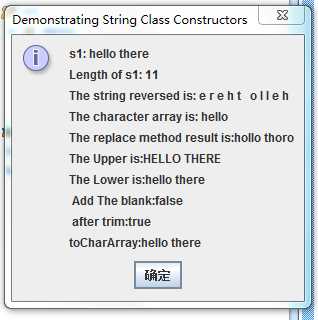标签:
String.Equals()使用方法
用来比较String两个对象所表示的字符串是否相同
public class StringEquals {
public static void main(String[] args) {
String s1=new String("Hello");
String s2=new String("Hello");
System.out.println(s1==s2); //false
System.out.println(s1.equals(s2)); //true
String s3="Hello";
String s4="Hello";
System.out.println(s3==s4); //true
System.out.println(s3.equals(s4)); //true
}
}
类的对象不能直接用==比较 比较的是两个String对象 不能用来比较对象和常量
对一些string 方法的测试 代码如下:
package demo;
//StringMisc.java
//This program demonstrates the length, charAt and getChars
//methods of the String class.
//
//Note: Method getChars requires a starting point
//and ending point in the String. The starting point is the
//actual subscript from which copying starts. The ending point
//is one past the subscript at which the copying ends.
import javax.swing.*;
public class Stringmisc {
public static void main( String args[] )
{
String s1, output,s2,s3;
char charArray[];
s1 = new String( "hello there" );
charArray = new char[ 5 ];
// output the string
output = "s1: " + s1;
// test the length method
output += "\nLength of s1: " + s1.length();
// loop through the characters in s1 and display reversed
output += "\nThe string reversed is: ";
for ( int i = s1.length() - 1; i >= 0; i-- )
output += s1.charAt( i ) + " ";
// copy characters from string into char array
//四个参数的含义
//1.被拷贝字符在字串中的起始位置
//2.被拷贝的最后一个字符在字串中的下标再加1
//3.目标字符数组
//4.拷贝的字符放在字符数组中的起始下标
s1.getChars( 0, 5, charArray, 0 );
output += "\nThe character array is: ";
for ( int i = 0; i < charArray.length;i++ )
output += charArray[ i ];
//test the replace method
s2 = s1.replace("e","o"); //replace方法完了转换后是返回一个新的对象,如果没有找到需要替换的字符串则返回原对象
output +="\nThe replace method result is:"+s2;
//test the toUpperCase and tpLowerCase
s2 = s1.toUpperCase(); //toUpperCase 是把所有字符串变为大写
s3 = s1.toLowerCase(); //toLowerCase 是吧所有字符串变为小写
output += "\nThe Upper is:"+s2;
output += "\nThe Lower is:"+s3;
//test The trim //去掉字符串首位的空格
s2 = " Hello There ";
s3 = "Hello There";
output += "\n Add The blank:"+s3.equals(s2);
s2 = s2.trim();
output += "\n after trim:" + s2.equals(s3);
//test the toCharArray //把字符串存入一个字符数组中
char array[] = s1.toCharArray();
output += "\ntoCharArray:";
for ( int i = 0; i < array.length;i++ )
output += array[ i ];
JOptionPane.showMessageDialog( null, output,
"Demonstrating String Class Constructors",
JOptionPane.INFORMATION_MESSAGE );
System.exit( 0 );
}
}

标签:
原文地址:http://www.cnblogs.com/zczhtml/p/4899094.html